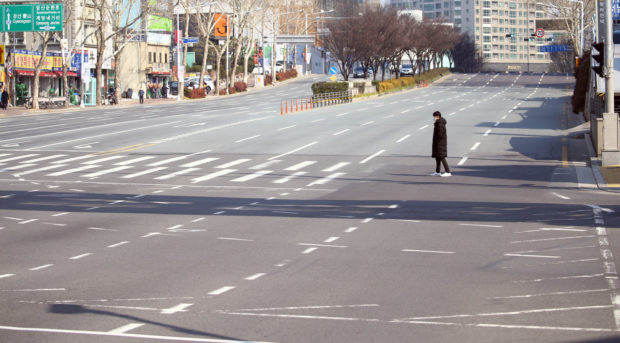New cases challenge Korea’s coronavirus response

A street in central Daegu on Thursday. Following more than 30 confirmed cases of COVID-19, citizens in the southern city are avoiding public places. Yonhap via The Korea Herald/Asia News Network
SEOUL — The novel coronavirus outbreak in Korea has reached a turning point, with fears of transmission within local communities appearing to have been realized.
As of Thursday afternoon, 82 people here have been confirmed to have the COVID-19 virus, most of whom appear to have contracted the virus from the 31st patient, who has no recent record of traveling overseas or coming into contract with other confirmed patients.
Following the developments, the government is changing its tone.
“Cases where the route of infection is difficult to identify are occurring in the country. The situation is that the reins of response must once again be tightened,” Prime Minister Chung Sye-kyun said Wednesday.
Chung’s comment is a turnaround from those from top officials, including President Moon Jae-in, in the days prior, who stressed that the outbreak is being managed and the country should focus on shoring up the economy against the impact of the outbreak.
Article continues after this advertisementDespite Seoul’s comparatively rapid and efficient response to the outbreak, the government faced criticism from medical professionals from the outset.
Article continues after this advertisementThe Korean Medical Association, which called for a wider entry ban from travelers from China, on Wednesday urged the government to change its strategy to focus on minimizing the damage.
“(The response) must be change to a strategy for minimizing deaths, and progression into severe conditions,” the KMA said, saying that the strategy of containment has failed.
The characteristics of COVID-19 may also add difficulties for quarantine authorities, with the latest findings suggesting the virus is more infectious in the early stages of infection.
On Thursday, the National Medical Center’s clinical committee for new infectious diseases said the COVID-19 was shown to be more infectious in its early stages when symptoms are mild, which may lead to the virus being spread before patients are diagnosed.
“Community spread is highly probable at this point,” said Bang Ji-hwan, the head of the national clinical management network for emerging infectious diseases.
The committee called for revisions to existing administrative and medical systems to allow for a full utilization of public health resources, as well as government support for developing vaccine and treatment.
Although the experience with the Middle East respiratory syndrome outbreak of 2015 aided in the government’s response to the current outbreak, the two situations vary in a number of significant ways.
The COVID-19’s spread appears slower than that of the MERS virus for the time being, yet the current situation involves a wider range of variables. MERS was first confirmed on May 20, 2015, and within a month over 100 people were diagnosed.
MERS entered Korea from the Middle East, a region with relatively little exchange with South Korea. In contrast, China is one of Korea’s closest neighbors with millions of people traveling back and forth between the countries each year.
In addition, unlike the virus responsible for MERS – which entered the country from a relatively limited geographical region – COVID-19 has been confirmed to have entered the country from other countries in addition to China. So far, two confirmed cases here contracted the virus in Singapore, and another one each in Japan and Thailand.
The degree to which symptoms manifest also appears to have a large spectrum, as demonstrated by the 28th patient.
No. 28 is a 31-year old Chinese woman who was diagnosed 16 days after her last contact with the third patient, who is thought to have transmitted the virus to her. The 28th patient also showed little to no symptoms, and the level of COVID-19 detected in her system is said to have been on the border between negative and positive results.
The 28th patient, who has since been discharged from the hospital, also cast doubt on the incubation period, which the Korean and other governments have considered to be 14 days.
In contrast, MERS symptoms developed and intensified comparatively quickly, with a much higher fatality rate, coming to about 20 percent in Korea.
For more news about the novel coronavirus click here.
What you need to know about Coronavirus.
For more information on COVID-19, call the DOH Hotline: (02) 86517800 local 1149/1150.
The Inquirer Foundation supports our healthcare frontliners and is still accepting cash donations to be deposited at Banco de Oro (BDO) current account #007960018860 or donate through PayMaya using this link.